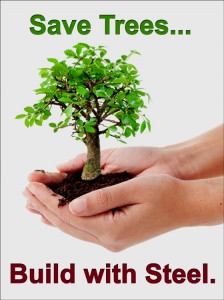Which is Greener— Wood or Steel Buildings?
When considering wood vs. steel buildings, it is important not to overlook the environmental implications of the two systems. Which substance leaves a smaller environmental footprint? Let’s explore which is a more eco-friendly building material.
ENVIRONMENT
 WOOD framing proponents crow that wood is more sustainable than steel. Wipe out a forest harvesting trees for virgin lumber? No problem! Simply replant more trees, right?
WOOD framing proponents crow that wood is more sustainable than steel. Wipe out a forest harvesting trees for virgin lumber? No problem! Simply replant more trees, right?
However, even the fastest growing softwood tree species need 30-40 years to mature. Stronger hardwood trees take even longer to reach maturity. For example, a Douglas fir requires 100 years or more to reach only 18” in diameter. The Longleaf Pine needs 100-150 years to grow to full maturity.
STEEL manufacturing today takes less than one man-hour to produce a ton of recycled steel.
AVAILABILITY
WOOD: About five acres of forest must be harvested to produce the lumber for a 10,000 square-foot structure. In one year, the trees in that same five acres of forest— if left to grow—absorb the carbon dioxide equal to 65,000 miles of automobile pollution.
STEEL: Recycling the steel from 30-35 junked cars produces enough steel framing for the same 10,000 square-foot building.
ENERGY EFFICIENCY
Buildings drain 40% of all energy used in the U.S.— and suck up 73% of all electricity. Experts estimate that 30% or more of the energy consumed by commercial buildings is wasted energy.
WOOD is a poor conductor of heat and cold. Consequently, you would expect wood-framed structures to be more energy efficient to heat and cool than steel. But are they really?
STEEL: Heat and cold travels easily through metals like steel. This thermal transference creates an insulating problem for metal buildings— especially for light-gauge steel framing which mimics traditional lumber-framed construction.
Pre-engineered rigid-iron steel buildings negate thermal transference two ways:
1. Red-iron steel buildings produce much thicker walls than ordinary wood framing. The deeper rigid-steel wall cavity creates room for far more insulation than 2×4 wood studs— or even the 2×6 light-gauge metal studs.
2. Premium insulation systems like RHINO’s Pro-Value Insulation include a second layer of insulation that creates a thermal break. RHINO buildings with Pro-Value insulation slash heating and cooling bills in half. Optional reflective cool-coated steel roofing saves even more energy.
RECYCLING
WOOD: Once the building outlives its usefulness, the owner must pay to have the wood hauled to the nearest dump, where it joins the estimated 460 million tons of construction and demolition waste generated annually in the U.S.
Some lumber is chemically treated to discourage rot and insects. Treated wood is not deemed safe for livestock structures.
Over time, discarded treated wood slowly transfers its chemicals into the ground as it deteriorates in overcrowded landfills.
It is possible to recycle untreated wood framing into wood chips.
STEEL is the most recycled material in the world.
Steel is the only material that does not lose any strength when recycled. In fact, steel’s strength remains the same regardless of how many times it recycles. Today, 98% of all steel products are recycled.
The magnetic properties of steel make it simple to handle. Steel easily separates from other material when electromagnets are employed.
All new steel contains recycled steel.
Steel scrap is so valuable, many metal scrap companies actually pay building owners to demolish a steel-framed building.
Pre-engineered steel framing complies with guidelines for:
• ANSI Green Building Protocols for Commercial Buildings
• ASHRE Standards for the Design of High-Performance Green Buildings
• LEED Green Building Ratings
• National Green Building Standards
• The International Green Construction Code
• U.S. Council on Green Building
FOUNDATIONS
WOOD: Lumber-framed buildings rest on concrete. The foundations can be slab, pier, or perimeter walls.
STEEL buildings also rest on concrete slab, pier, or perimeter walls.
Because steel actually enjoys a greater strength-to-weight ratio that wood or other building materials, fewer pieces produce a lighter overall structure. Consequently, steel requires less concrete than wood-framed buildings, reducing the cost of the foundation.
Why is the amount of concrete used environmentally important? Because most concrete used in construction eventually piles up in landfills.
Steel buildings also last longer than wood structures, further reducing concrete debris.
HEALTH
The Centers for Disease Control (CDC) estimates Americans spend 90% of their time indoors. Consequently, indoor air quality dramatically affects the health of a structure’s occupants.
WOOD is an organic material. Under the right conditions, mold and mildew feed and multiply on lumber. Spores formed by mold and mildew compromise indoor air quality (IAQ).
Composite wood products outgas, further undermining IAQ.
STEEL: As an inorganic material, steel is impervious to mold and mildew. Steel never outgasses.
A well-insulated steel building reduces the outdoor noise level, too.
If you missed part 1 and part 2 of this series on wood versus steel buildings, be sure to review those blogs as well. Then call RHINO with any questions you have about pre-engineered metal buildings and their suitability for your upcoming building project.
RHINO’s experienced and professional steel building specialists gladly answer questions, offer sound advice on building projects, and provide free quotes. The RHINO number is 940.383.9566.
